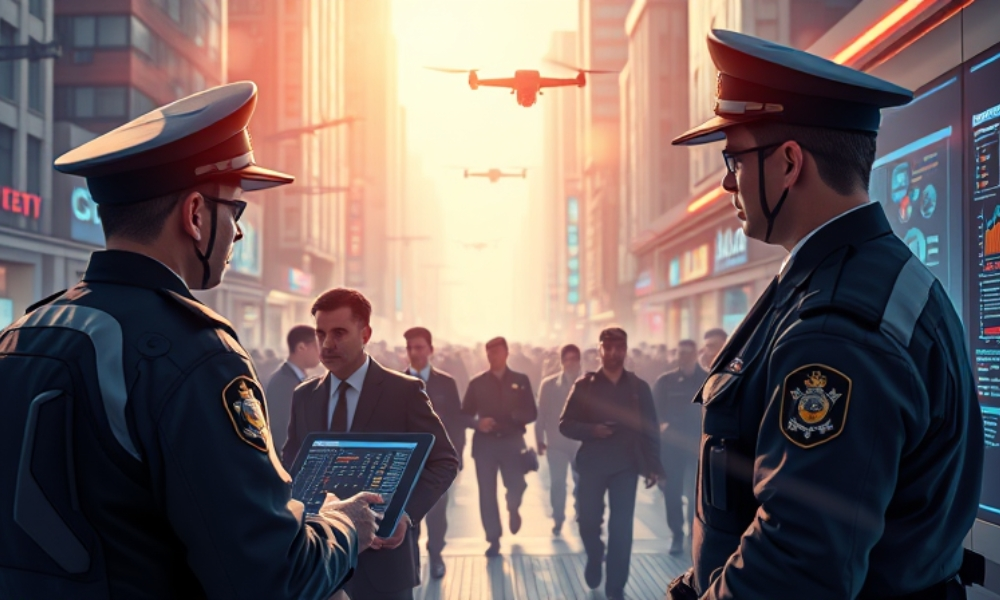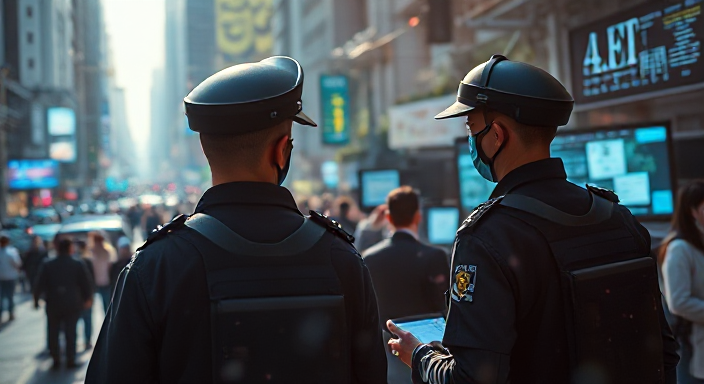Artificial Intelligence
Enhancing Law Enforcement With AI Policing Tools
Discover how AI technologies are reshaping law enforcement, from predictive analytics to facial recognition, while tackling crucial ethical and privacy concerns to build safer, more just communities.

Application of Artificial Intelligence (AI) in policing is a rapidly developing concept that affects most areas by increasing effectiveness and reducing the time required to complete tasks. From video surveillance to the License plate recognition (LPR) systems, these advanced tools are already out in the field.
Definition:
Are we ready for the opportunities AI holds for the future of public safety or to learn how it is enhancing lives currently?
Role of AI in Law Enforcement:
Why should law enforcement use AI tools?
It has beyond any doubt made data analysis extremely efficient, it has automated mundane tasks, and it has become a go-to system in emergency decision-making processes. One of the challenges with working with big data is that it takes a lot of time to sort through such data manually, but not with AI. For instance, explicative-forecasting tools provide the crime map and help in allocating scarce resources efficiently to the police force.
What benefits does AI bring to crime prevention?
Rapid Investigation: Thus, the use of AI to scan results of surveillance cameras can be useful in eliminating suspects without the consumption of so much time.
Data-Driven Decisions: When information is precise then policing authorities are able to properly assign forces to areas that are most vulnerable.
Enhanced Officer Safety: Specifically, through the analysis of live data streams, AI gives an alert to the officers when there is a likelihood of an attack.
Predictive Policing: AI performs an analysis of crimes committed in the past so that the police can prevent similar events from happening again in the future. This minimizes cases of criminal activities while at the same time enhancing efficiency of patrols’ time table.
Facial Recognition Technology: Real-time comparison of face templates with criminal databases makes AI-based facial recognition faster than identification by guards, which increases security during mass events and in critical territories.
Cybercrime Detection: Machine learning compares patterns on networks with normal ones to flag potential cyber threats like phishing or data theft and do it more effectively than manually.
Behavioral Analysis: AI can identify and interpret human conduct by detecting their postures as well as movement; this is likely to pin point suspicious actions within a crowded setting more so places like public places or prisons.
Automated Threat Detection: AI systems monitor data from hundreds and thousands of sensors and cameras, and communication networks, and alert security of possible threats at the earliest opportunity, enhancing response times.
Real-Time Language Processing: Sophisticated artificial intelligence extracts and interprets information from the spoken word and can recognize words or phrases in one or many languages associated with criminality, including terrorism or human trafficking.
Forensic Evidence Analysis: AI contributes to the speeding up the process of examination of the forensic samples through such subprocesses as fingerprint identification, DNA typing, or ballistic identification achieved faster with high level of accuracy.
Real-world applications such as identifying trends in violent crime or flagging illegal activities demonstrate how AI addresses challenges efficiently.

AI-Powered Voice and Video Solutions:
Video Analytics for Surveillance:
In this paper, the authors argue that intelligent video surveillance, through behavioral pattern recognition and face identification, changes the meaning of surveillance. Cops in the field with facial recognition can run suspects against criminal databases in a matter of seconds. Behavioral analysis is also more preventive than reactive; it identifies potential criminal actions and conducts.
Applications Include:
- Scanning large public areas for missing persons.
- Monitoring vehicle movement during events.
- Detecting unusual behaviors, such as loitering, to prevent crimes.
Case Study: The solutions involving AI during the 2019 Super Bowl were used for enhancing and protecting video that in turn helped to detect security threats in large crowds.
AI in Audio Analysis:
A similar concept also applies to audio analysis tools. Communication recording or phone call transcription tools convert the audio feed of a phone call or surveillance into text data that can be searched in real-time. Language translation features help to overcome language barriers which are so vital in today’s interconnected work of different law enforcement teams.
Usage Examples:
- Recognizing keywords during suspect interrogations.
- Alerting officers about threatening phrases in radio communications.
- Translating non-English recordings during international criminal probes.
License Plate Recognition (LPR) Technology:
How does license plate recognition work?
LPR technology scans and recognize numbers from license plates through cameras that uses artificial intelligence. The plates are checked against databases within moments to find out if the car belongs to a stolen one or if the suspect associated with the plate number is wanted.
Key Applications:
1. Traffic Surveillance: Undertaking measures such as ensuring that vehicle owners obey the put in place speeds limit and other road safety measures.
2. Tracking Suspects: Surveillance of criminals during investigations as a utilization of surveillance cameras.
3. Locating Stolen Vehicles: With LPR, it takes the police a short time to recover stolen vehicles.
4. Crime Pattern Analysis: LPR data is particularly helpful in the process of identifying crime hotspots as well as criminal movement throughout certain areas of interest to officers.
5. Smart Emergency Response: In emergency situations, LPR systems can easily distinguish in between first responder automobiles and organize them to attend to emergencies correctly.
6. Drone-Assisted Monitoring: LPR combines with drone to provide surveillance coverage and efficiency by extending surveillance areas, especially over large and otherwise hard to surveil terrains.
7. Digital Evidence Collection: The LPR systems record the timestamped data of the vehicles, which can be used as the strong digital evidence during court proceedings and help in investigations with proper information.
Global Notable Case: The LPR technology was employed by UK police positively to apprehend criminals involved in carjacking, high speed chase, or otherwise involved in prohibited activities that endangered the lives of other people on the road.
Ethical Considerations in Using AI Tools:
How can privacy be balanced with security needs?
What might be noteworthy is that with the help of AI, law enforcement improves, however, ethical issues should be discussed. Facial recognition could be a violation of privacy if not regulated as follows: The incorporation of transparency in the utilization of artificial intelligence in policing leaves the public with trust and makes the authorities accountable within the framework of policing.
Suggested Measures:
- Adopting clear policies on data storage and usage.
- Inviting public oversight into AI adoption.
- Conducting regular audits to eliminate racial or gender biases.
This way, the agencies should be open, and the tools remain helpful while not easily manipulated by individuals in a community.
The Future of AI in Law Enforcement:
What’s next in AI policing?
Such emerging forms of AI technology like predictive policing are now coming to the fore. Use of predictive algorithms help in predicting areas of high crime rates based on past results; AI integrated drones help in surveillance at real time.
How can AI tackle cybercrime?
AI is gradually shifting to cybersecurity and it would be impossible for it not to do so. Looking at experiences from the digital world, investigating ransomware activities, and, more importantly, foreseeing new online attacks bring new approaches to combating crime. For the innovation to be sustained there should be a close working relationship between the technology inventors and the police services.
Challenges in Implementing AI Tools:
Why is implementing AI in law enforcement difficult?
Using Artificial intelligence tools is not without challenges as this section demonstrates. This is especially the case where the implementation of AI would be costly, for less-funded departments; also, as it is not always compatible with old systems. Further, the use of advanced AI demands a considerable amount of time, and it also costs a lot to train the training officers.
What solutions are available for these challenges?
- Securing federal grants for technological advancements.
- Partnering with technology providers for seamless system integration.
- Offering extensive training programs customized to law enforcement needs.
Through addressing these issues, it is possible for different organizations to fully unlock the application of AI in policing while avoiding disruption.
Bringing Technology and Law Enforcement Together:
That is why AI is so important for changing the future of law enforcement, as this concept is based on innovation and the attainment of significant results. Ideal from surveillance to investigations, these tools increase public safety in ways people could not imagine before.
Are AI policing tools the key to safer communities, and how should we balance privacy concerns with public safety advancements? Share your thoughts below!
-

 Artificial Intelligence8 months ago
Artificial Intelligence8 months agoWhat is Artificial Intelligence? A Comprehensive Guide for Businesses and Enthusiasts
-

 Artificial Intelligence6 months ago
Artificial Intelligence6 months agoHow to Use Grok AI: A Complete Guide
-

 Artificial Intelligence8 months ago
Artificial Intelligence8 months agoUnlocking the Power of Artificial Intelligence Tools
-

 Artificial Intelligence7 months ago
Artificial Intelligence7 months agoWhat is DeepSeek? Revolutionizing AI with Cutting-Edge Solutions
-

 Artificial Intelligence3 months ago
Artificial Intelligence3 months agoAI Technologies in Warehouse Automation:
-

 Artificial Intelligence4 months ago
Artificial Intelligence4 months agoMeta’s AI Push: The Standalone Assistant App Set to Rival ChatGPT
-

 Artificial Intelligence3 months ago
Artificial Intelligence3 months agoHow Artificial Intelligence is Revolutionizing Logistics:
-

 Artificial Intelligence3 months ago
Artificial Intelligence3 months agoPredictive Analytics for Demand Forecasting:


